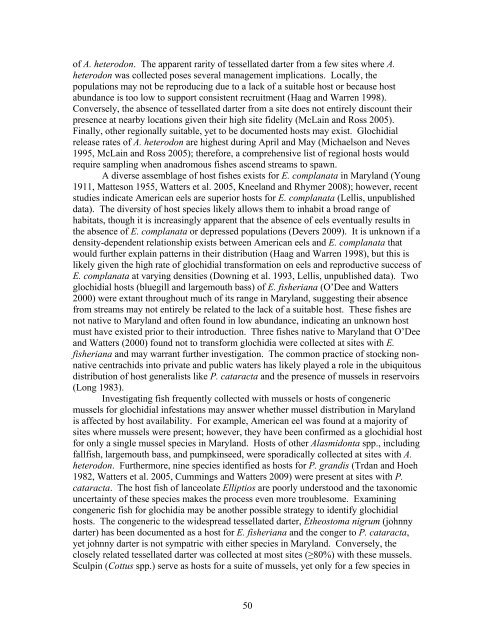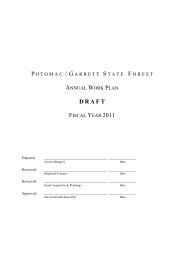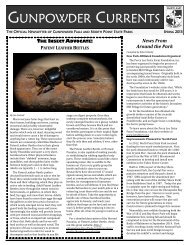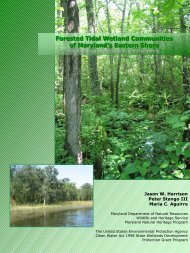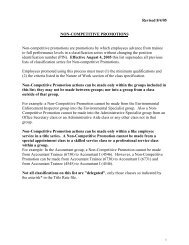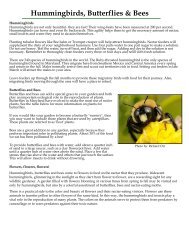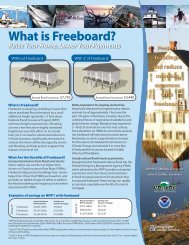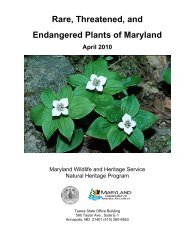Freshwater mussel records collected by the Maryland Department of ...
Freshwater mussel records collected by the Maryland Department of ...
Freshwater mussel records collected by the Maryland Department of ...
You also want an ePaper? Increase the reach of your titles
YUMPU automatically turns print PDFs into web optimized ePapers that Google loves.
<strong>of</strong> A. heterodon. The apparent rarity <strong>of</strong> tessellated darter from a few sites where A.<br />
heterodon was <strong>collected</strong> poses several management implications. Locally, <strong>the</strong><br />
populations may not be reproducing due to a lack <strong>of</strong> a suitable host or because host<br />
abundance is too low to support consistent recruitment (Haag and Warren 1998).<br />
Conversely, <strong>the</strong> absence <strong>of</strong> tessellated darter from a site does not entirely discount <strong>the</strong>ir<br />
presence at near<strong>by</strong> locations given <strong>the</strong>ir high site fidelity (McLain and Ross 2005).<br />
Finally, o<strong>the</strong>r regionally suitable, yet to be documented hosts may exist. Glochidial<br />
release rates <strong>of</strong> A. heterodon are highest during April and May (Michaelson and Neves<br />
1995, McLain and Ross 2005); <strong>the</strong>refore, a comprehensive list <strong>of</strong> regional hosts would<br />
require sampling when anadromous fishes ascend streams to spawn.<br />
A diverse assemblage <strong>of</strong> host fishes exists for E. complanata in <strong>Maryland</strong> (Young<br />
1911, Matteson 1955, Watters et al. 2005, Kneeland and Rhymer 2008); however, recent<br />
studies indicate American eels are superior hosts for E. complanata (Lellis, unpublished<br />
data). The diversity <strong>of</strong> host species likely allows <strong>the</strong>m to inhabit a broad range <strong>of</strong><br />
habitats, though it is increasingly apparent that <strong>the</strong> absence <strong>of</strong> eels eventually results in<br />
<strong>the</strong> absence <strong>of</strong> E. complanata or depressed populations (Devers 2009). It is unknown if a<br />
density-dependent relationship exists between American eels and E. complanata that<br />
would fur<strong>the</strong>r explain patterns in <strong>the</strong>ir distribution (Haag and Warren 1998), but this is<br />
likely given <strong>the</strong> high rate <strong>of</strong> glochidial transformation on eels and reproductive success <strong>of</strong><br />
E. complanata at varying densities (Downing et al. 1993, Lellis, unpublished data). Two<br />
glochidial hosts (bluegill and largemouth bass) <strong>of</strong> E. fisheriana (O’Dee and Watters<br />
2000) were extant throughout much <strong>of</strong> its range in <strong>Maryland</strong>, suggesting <strong>the</strong>ir absence<br />
from streams may not entirely be related to <strong>the</strong> lack <strong>of</strong> a suitable host. These fishes are<br />
not native to <strong>Maryland</strong> and <strong>of</strong>ten found in low abundance, indicating an unknown host<br />
must have existed prior to <strong>the</strong>ir introduction. Three fishes native to <strong>Maryland</strong> that O’Dee<br />
and Watters (2000) found not to transform glochidia were <strong>collected</strong> at sites with E.<br />
fisheriana and may warrant fur<strong>the</strong>r investigation. The common practice <strong>of</strong> stocking nonnative<br />
centrachids into private and public waters has likely played a role in <strong>the</strong> ubiquitous<br />
distribution <strong>of</strong> host generalists like P. cataracta and <strong>the</strong> presence <strong>of</strong> <strong>mussel</strong>s in reservoirs<br />
(Long 1983).<br />
Investigating fish frequently <strong>collected</strong> with <strong>mussel</strong>s or hosts <strong>of</strong> congeneric<br />
<strong>mussel</strong>s for glochidial infestations may answer whe<strong>the</strong>r <strong>mussel</strong> distribution in <strong>Maryland</strong><br />
is affected <strong>by</strong> host availability. For example, American eel was found at a majority <strong>of</strong><br />
sites where <strong>mussel</strong>s were present; however, <strong>the</strong>y have been confirmed as a glochidial host<br />
for only a single <strong>mussel</strong> species in <strong>Maryland</strong>. Hosts <strong>of</strong> o<strong>the</strong>r Alasmidonta spp., including<br />
fallfish, largemouth bass, and pumpkinseed, were sporadically <strong>collected</strong> at sites with A.<br />
heterodon. Fur<strong>the</strong>rmore, nine species identified as hosts for P. grandis (Trdan and Hoeh<br />
1982, Watters et al. 2005, Cummings and Watters 2009) were present at sites with P.<br />
cataracta. The host fish <strong>of</strong> lanceolate Elliptios are poorly understood and <strong>the</strong> taxonomic<br />
uncertainty <strong>of</strong> <strong>the</strong>se species makes <strong>the</strong> process even more troublesome. Examining<br />
congeneric fish for glochidia may be ano<strong>the</strong>r possible strategy to identify glochidial<br />
hosts. The congeneric to <strong>the</strong> widespread tessellated darter, E<strong>the</strong>ostoma nigrum (johnny<br />
darter) has been documented as a host for E. fisheriana and <strong>the</strong> conger to P. cataracta,<br />
yet johnny darter is not sympatric with ei<strong>the</strong>r species in <strong>Maryland</strong>. Conversely, <strong>the</strong><br />
closely related tessellated darter was <strong>collected</strong> at most sites (≥80%) with <strong>the</strong>se <strong>mussel</strong>s.<br />
Sculpin (Cottus spp.) serve as hosts for a suite <strong>of</strong> <strong>mussel</strong>s, yet only for a few species in<br />
50


